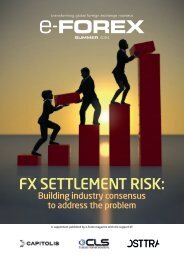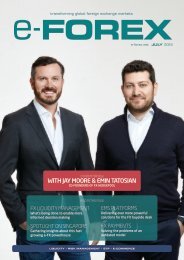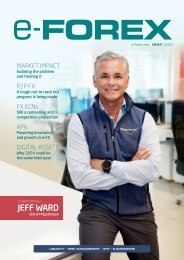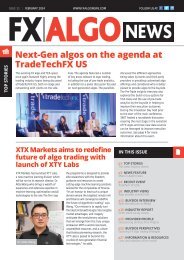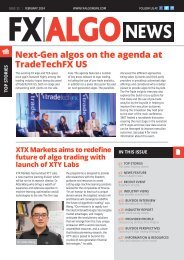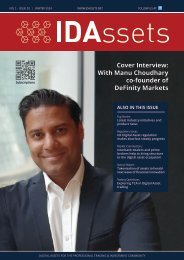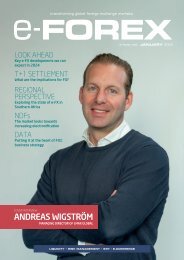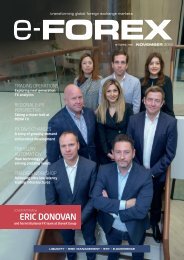Create successful ePaper yourself
Turn your PDF publications into a flip-book with our unique Google optimized e-Paper software.
Institutional digital assets: What are the evolutionary lessons from e-FX?<br />
DIGITAL CURRENCIES<br />
“I think we could see huge growth in institutional activity<br />
over the next three years, because everybody wants a new<br />
asset class to be exposed to...”<br />
intermediaries. “In the OTC FX market,<br />
intermediaries like banks and brokers<br />
play a critical role of enabling their<br />
customers to achieve their business<br />
goals – hedging, risk management,<br />
or speculation. As these customers<br />
enter the digital asset class, banks and<br />
brokers need battle-tested workflow<br />
automation technology to continue<br />
to serve them; this evolution is the<br />
driver behind the tremendous demand<br />
we are seeing for Integral Digital<br />
technology,” says Sanjay Madgavkar,<br />
CSO of Integral. A further factor<br />
shaping the market is regulation.<br />
“Governments and regulators around<br />
the world are becoming more focused<br />
on developing rules and guidelines<br />
to govern digital asset trading,” says<br />
Vinay Trivedi, COO of MaxxTrader. “We<br />
expect to see increased oversight in<br />
areas such as AML/KYC compliance<br />
and fraud prevention.”<br />
This regulatory influence will probably<br />
also favour the use of standardised<br />
derivative products, such as futures,<br />
but given their proven utility with<br />
hard to settle assets, non-deliverable<br />
forwards (NDFs) also look likely to<br />
play a part. Some institutions are<br />
also trying to create baskets of digital<br />
assets that can be traded as an asset<br />
class in their own right.<br />
Sanjay Madgavkar<br />
Elsewhere, institutions are already<br />
looking for the same sort of full suite<br />
prime brokerage services they currently<br />
have for FX. Apart from robust<br />
clearing infrastructure, significant<br />
balance sheet will also be required to<br />
support serious institutional volume.<br />
RIGHT PLATFORM, RIGHT<br />
SPEED<br />
Digital assets are effectively following<br />
the inverse of FX’s timeline. In the<br />
early days of FX, commercial demand<br />
from corporates and asset managers<br />
meant that institutional FX activity led<br />
the way, with retail activity following<br />
later. In the case of digital assets, retail<br />
has been the first mover, so as yet<br />
there are none of the institutionalgrade<br />
trading venues found in FX.<br />
While there are listed futures contracts<br />
available for a few cryptos, institutions<br />
are ultimately looking for a far<br />
broader range of digital assets with<br />
appropriate liquidity and infrastructure<br />
resilience.<br />
In the short term, this means that<br />
latency is not much of an issue, given<br />
the fragmented and retail nature<br />
of the industry. However, once<br />
institutional traders start moving large<br />
volume this will change and (as for<br />
FX) the emergence of low-latency<br />
connectivity services is likely to have<br />
a transformational impact on market<br />
access.<br />
DATA, ANALYTICS AND<br />
LIQUIDITY MANAGEMENT<br />
The institutional trading of digital<br />
assets will inevitably drive demand<br />
for associated data and analytics.<br />
As in FX, quants will require data for<br />
model building and calibration, risk/<br />
compliance functions will need it to<br />
monitor exposures, while regulators<br />
will want it for monitoring capital<br />
ratios. In anticipation of this demand,<br />
companies such as GCEX, MaxxTrader<br />
and Integral already include<br />
comprehensive data and analytics for<br />
digital assets in their product offerings.<br />
Analytics and associated technology<br />
also have an important role to play<br />
if enhanced liquidity management<br />
of digital assets is to emulate the<br />
efficiencies achieved through flow<br />
aggregation in FX. Again, entities<br />
servicing this space are already using<br />
similar or identical FX technology to<br />
achieve this. “Obviously there are<br />
some tweaks but it is essentially the<br />
same,” says Lars Holst. “Dealing with<br />
things such as airdrops makes it a<br />
little more complex as they don’t have<br />
an exact counterpart in conventional<br />
assets.”<br />
Ultimately, proven FX technology -<br />
such smart order routing - will provide<br />
access to a larger pool of digital asset<br />
liquidity, which will make trading more<br />
efficient and reduce transaction costs.<br />
Coupling this with institutional-grade<br />
Vinay Trivedi<br />
“Regulators may impose stricter rules on HFT, and market<br />
participants will need to adapt their strategies to new<br />
liquidity pools and market structures,”<br />
60 MAY 20<strong>23</strong> e-FOREX




